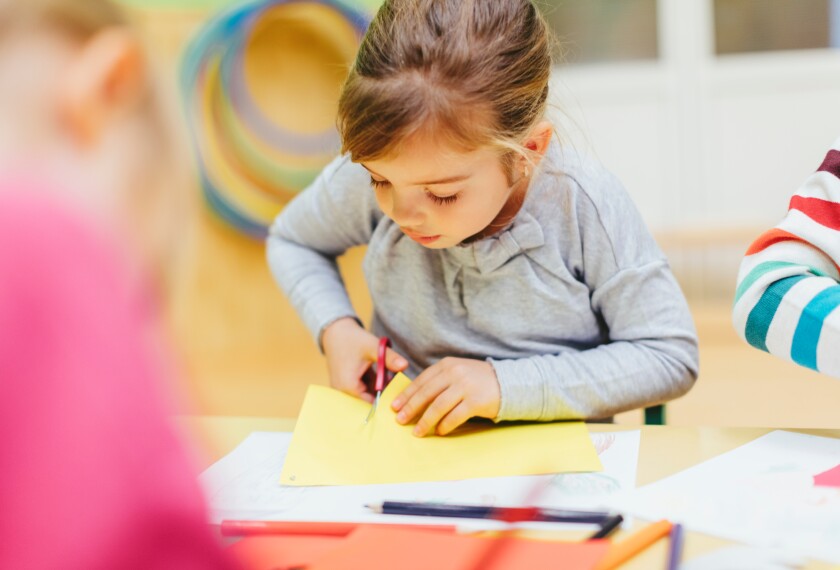Educational technology in the classrooms of young children is here to stay.
Now, experts say, the challenge is to ensure that all those tablets, laptops, apps, and software programs are used appropriately.
“There is great potential, but we need to be thoughtful and intentional,” said Kyle Snow, the research director of the National Association for the Education of Young Children, a Washington-based nonprofit. “At the end of the day, it’s still a screen, and we still have to worry about all the bad habits we’ve developed with other technologies.”
The key, say Mr. Snow and others, is making sure that ed-tech is incorporated into a well-rounded classroom. It should add new dimensions to young children’s experiences, helping them learn not just to recognize letters and understand numbers, but to explore the real world, interact more closely with adults, and create their own magic.
Preschools and early-childhood centers are likely to have technologies such as digital cameras, computers, and televisions, according to a 2012 survey by the NAEYC and other organizations. Digital tablets and e-readers are less prevalent, and use of such devices may be sporadic, even when they are present.
In the elementary grades, laptops and tablets have become more popular.
But effective technology use is about more than what hardware is in the classroom, said Lisa Guernsey, the director of the Early Education Initiative at the New America Foundation, a Washington think tank.
“It behooves all of us to better understand how technology is being used, what is the content children are seeing on the screen, and how that is integrated into what they are supposed to be learning,” Ms. Guernsey said.
The software and app market, for example, has exploded in recent years. Digital math tools for young learners are evolving from quiz-based apps and games to digital environments that require children to solve real-life problems. Literacy tools are moving from online libraries to diagnostic programs that assess students’ reading levels and provide targeted lessons and materials. A growing number of apps and software programs aim to address young children’s “social-emotional” learning.
Experts say a healthy trajectory begins with limited use of such tools to help preschoolers become comfortable handling devices, explore the world around them, and begin building basic skills. Later, software and apps may become more gamelike, targeting specific skills and content.
By 2nd and 3rd grades, ed-tech tools may be adaptive, automatically diagnosing a child’s reading level or mastery of mathematical concepts. Children in those grades should be exposed to the Internet and content-creation tools, learning how to safely search for information and organize it into everything from presentations to comic books.
Despite considerable hype, solid evidence of how educational technologies support young children’s learning remains scant. Worse, teachers and parents often have difficulty finding high-quality digital tools.
“Unfortunately, you get a lot of rote-learning applications that aren’t appropriate,” said Seeta Pai, the vice president of research at Common Sense Media, a San Francisco nonprofit.
As a result, she said, schools have an increasingly important role to play. That’s especially true because children’s use of digital technology at home has exploded. According to a 2013 survey by Common Sense Media, 75 percent of children 8 years old or younger have now used a mobile device, more than twice the proportion of just two years prior.
As with television, researchers are worried about obesity, attention span, poor social skills, and other problems resulting from too much screen time.
Parents are also worried about the privacy and security of their children’s personal information, and researchers have found evidence that some of the e-books and other digital resources may actually diminish youngster’s ability to comprehend what they read.
And stark differences continue to exist between wealthy and poor communities, both in terms of children’s access to educational technology and whether their schools are asking them to produce their own content or engage in drill-and-kill practice of basic skills.
Some exemplars of effective ed-tech usage in the early years have emerged, even within traditional school environments.
That’s good—experts say it’s more important than ever for parents and educators to be able to recognize healthy use of digital tools.
These days, that means looking at more than just total screen time, said Michael H. Levine, the executive director of the Joan Ganz Cooney Center at Sesame Workshop, a nonprofit research center based in New York City.
The best uses of technology, he said, are “like a ping-pong match,” with extensive back-and-forth between children and adults.
“It’s not when a device takes over the whole class, but when technology helps a child to go out and discover something in her environment,” Mr. Levine said. “It’s time to embrace ed-tech, but we have to do it carefully.”





